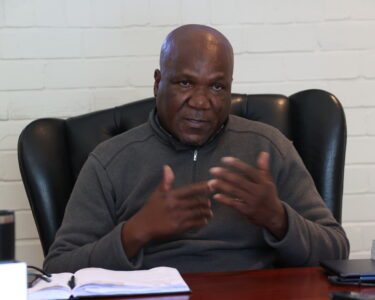Zimplats Holdings Limited (Zimplats), Zimbabwe’s largest Platinum Group Metals (PGM) producer, continues to pump millions of dollars into its expansion programmes that, in recent months, have seen the company opening up Mupani Mine and constructing a third concentrator to boost production. As Munyaradzi Huni reports, the projects are a clear testimony that Zimplats is in the country for the long haul.
If there is anyone out there who doubts that Zimbabwe is indeed “Open for Business” and that international companies are heeding the Second Republic’s call to invest in the country, he/she should take a closer look at the massive investments taking place at Zimplats, courtesy of the majority shareholder, Impala Platinum Holdings (Implats).

Brick by Brick ‘goes underground’
Located on the Hartley Geological Complex on the Great Dyke south-west of Harare, Zimplats is the epitome of a mining nerve centre bustling with activity.
A subsidiary of South Africa’s Implats, Zimplats started mining operations in 2001 and currently operates five underground mines that supply ore to four concentrator modules – three at Ngezi and the fourth at the Selous Metallurgical Complex (SMC). The PGM miner employs over 8,900 workers, including contractors.
As the say, “seeing is believing”. The Brick by Brick magazine team recently visited Zimplats to catch a glimpse the two “new babies” under the company’s expansion programme – Mupani Mine and the Third Concentrator.
This was a red-carpet event hosted by the Mupani mine manager, Harmony Muzhizhizhi, geologist Julius Poterai and the safety, health, environment and quality officer, Belinda Ncube on the surface. The highlight of our visit was, no doubt, the rare opportunity to go underground, where we met by the senior mine captain, Godfrey Chipfupi, overseer miner Mildred Kurauwone and the ventilation officer, Taiti Chikwezvero.
Working “down under” is certainly not for the faint-hearted. But without the hard-hatted men and women we met in the bowels of the earth, the US$12 billion mining industry would remain nothing but a pipedream. Kudos to the Zimplats chief executive officer, Alex Mhembere, and his tireless team! They are, indeed, proving to be bricklayers par excellence when it comes to building Zimbabwe brick by brick as espoused by His Excellency President Mnangagwa.
Projects worth US$1.8 billion in the pipeline
Expansion projects worth US$1.8 billion, with the potential to create an additional 2,000 jobs and thousands more in downstream linkages, have been lined up in the next 10 years beginning 2021.
In June 2016, Zimplats started the development of Mupani Mine with a view to replacing ore production from Rukodzi Mine (depleted in 2022) and Ngwarati Mine, which is expected to be depleted in 2024. The Mupani Mine project is planned to also replace some of the tonnage contribution from Mupfuti Mine after its scheduled depletion in 2027, with the remainder of the production coming from Bimha Mine.
According to projections, Mupani Mine is being developed to deliver a capacity of 3.6 metric tonnes per annum (Mtpa) by August 2028. The development of the mine has reached 53%, having completed surface and ore handling infrastructure and associated ventilation system to achieve 2.2 metric tonnes per annum production by 2024.


To prove that it means business, Zimplats, in the last quarter of 2022, completed the construction of a Third Concentrator plant at a cost of US$104 million, which will increase the milling capacity by 0.9 metric tonnes per year.
Cumulative project expenditure as at the end of the first quarter amounted to US$91.3 million with US$9.3 million committed against a project budget of US$104.1 million. To sustain operations at the SMC concentrator, more so in view of the existing tailings storage facility (TSF) at SMC forecast to reach its maximum design height of 43 metres in the next two years or so, Zimplats is extending the TSF, having completed 52% of the construction of the expanded facility.
It took about 20 months to complete the implementation of the project. During the project phase and after, there was emphasis on local procurement, with over 700 people working on the project at its peak. Now that the project is up and running, it has the effect of increasing throughput capacity from 6.7Mtpa to 7.6Mtpa.
With a workforce of 96 people, the plant will receive ore from Bimha and Mupani mines, with the concentrate produced being exported to Impala South Africa for smelting.
More millions pumped into Zimbabwe
Zimplats has also commenced construction of a 38MW furnace and a sulphuric acid plant at a combined cost of US$521 million. The bigger furnace will increase the smelter capacity from the current 132,000 tonnes of concentrate per year to 380,000 tonnes. The twin benefit of the SO2 abatement plant, commonly referred to as sulphuric acid plant, is immeasurable as it cleans the environment of SO2 pollution while the waste sulphuric acid is a major input in fertiliser manufacturing.
There are also plans to establish, in four implementation phases, a 185MW solar photovoltaic plant at a cost of US$201 million. The final phase is scheduled for completion in 2027. Apart from powering the mines and processing facilities, the solar project will also go a long way in reducing Zimplats’ carbon footprint.
Implementation of the 35MW solar plant, which is phase one of the 185MW solar project, progressed during the last quarter of 2022. The solar plant is being constructed at SMC and is targeted for completion in 2024.
Work is also in progress to finalise studies on establishing a Base Metal Refinery at an estimated cost of US$190 million and a new mine – Hartley or Portal 10 – at a cost of US$280 million.
At the same time, progress continues to be made with regard to the rolling out of housing units for Zimplats’ employees at Turf and the housing development project in Chegutu.
A synopsis of Zimplats’ expansion programmes
After taking over BHP’s share of Hartley Mine in the late 1990s, Zimplats proceeded to establish an open pit mine at Ngezi with a capacity to produce 2.2 metric tonnes per annum (Mtpa), leading to the resuscitation of the concentrator and smelter at SMC between 2001 and 2005.
The period 2006 to 2010 was yet another exciting one for Zimplats, when the company committed US$340 million in Phase 1 expansion, which entailed increasing mining and concentrator capacity from 2.2Mtpa to 4.2Mtpa. That expansion entailed setting up the 2.0Mtpa Bimha Mine and the Ngezi Concentrator Module 1.
The Phase 2 expansion programme commenced post commissioning of Phase 1 in 2009. Its scope involved the development of a fourth underground mine (Mupfuti) and the establishment of a second concentrator module at Ngezi to increase nameplate capacity from 4.2Mtpa to 6.2Mtpa. Also included under this phase was the construction of Chitsuwa Dam to supply water for Zimplats’ operations, Turf Town and the Ngezi community.



